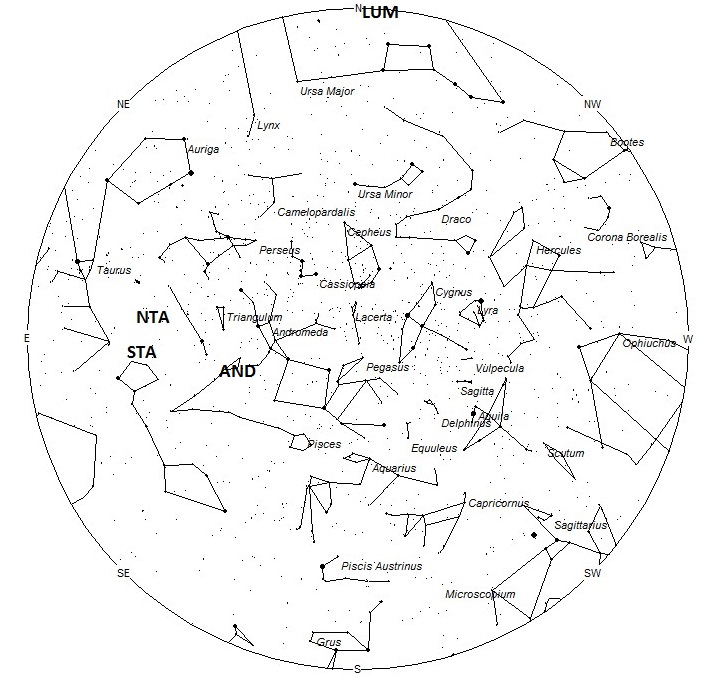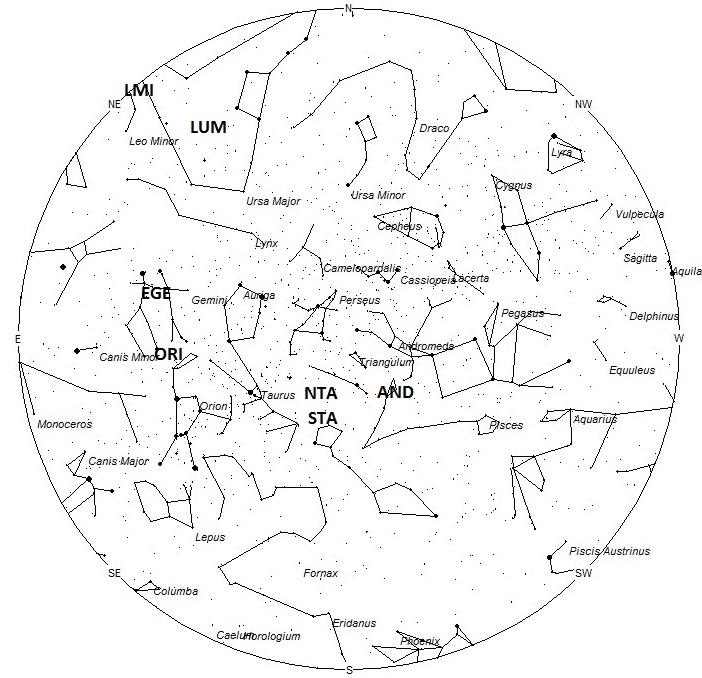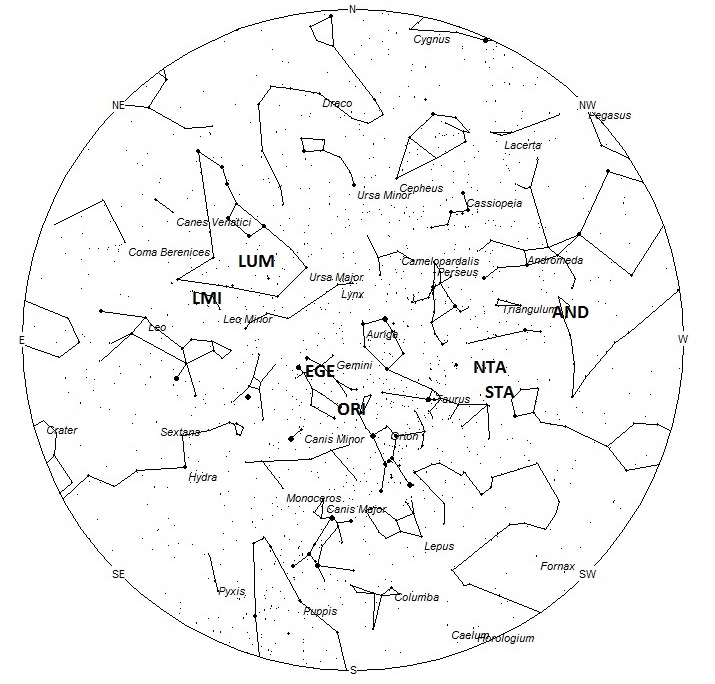During this period the moon reaches it last quarter phase on Saturday October 22nd. At this time the moon will be located 90 degrees west of the sun and will rise between 2300 and midnight local summer time (LST). This weekend the moon will interfere with viewing the maximum of the Orionid meteor shower but circumstances are much better than viewing during a full moon. Simply make certain you view with the moon at your back so that the lunar glare does not impede your vision. As the week progresses the moon becomes less of a problem as the phase wanes and it rises later in the morning with each passing night. The estimated total hourly meteor rates for evening observers this week is near 5 as seen from mid-northern latitudes (45N) and 3 as seen from tropical southern locations (25S). For morning observers the estimated total hourly rates should be near 30 as seen from mid-northern latitudes (45N) and 25 as seen from tropical southern locations (25S). The actual rates will also depend on factors such as personal light and motion perception, local weather conditions, alertness and experience in watching meteor activity. Morning rates are reduced this week due to moonlight. Note that the hourly rates listed below are estimates as viewed from dark sky sites away from urban light sources. Observers viewing from urban areas will see less activity as only the brightest meteors will be visible from such locations.
The radiant (the area of the sky where meteors appear to shoot from) positions and rates listed below are exact for Saturday night/Sunday morning October 22/23 These positions do not change greatly day to day so the listed coordinates may be used during this entire period. Most star atlases (available at science stores and planetariums) will provide maps with grid lines of the celestial coordinates so that you may find out exactly where these positions are located in the sky. A planisphere or computer planetarium program is also useful in showing the sky at any time of night on any date of the year. Activity from each radiant is best seen when it is positioned highest in the sky, either due north or south along the meridian, depending on your latitude. It must be remembered that meteor activity is rarely seen at the radiant position. Rather they shoot outwards from the radiant so it is best to center your field of view so that the radiant lies at the edge and not the center. Viewing there will allow you to easily trace the path of each meteor back to the radiant (if it is a shower member) or in another direction if it is a sporadic. Meteor activity is not seen from radiants that are located below the horizon. The positions below are listed in a west to east manner in order of right ascension (celestial longitude). The positions listed first are located further west therefore are accessible earlier in the night while those listed further down the list rise later in the night.
These sources of meteoric activity are expected to be active this week.
The first activity from the Andromedids (AND) will be seen this week. This is a famous shower that produced some brilliant displays during the 19th century. Since then the main orbit of the particles from comet 3D/Biela have moved away from the Earth. Still, remnants may be seen from October 26 through November 20 with maximum activity occurring on November 8. The radiant is currently located at 01:12 (018) +20, which lies in northern Pisces, directly between the two 4th magnitude stars known as eta Andromedae and eta Piscium. Rates would most likely be less than 1 per hour no matter your location. The radiant is best located near midnight LST when the radiant lies highest above the horizon. With an entry velocity of 19 km/sec., the average Andromedid meteor would be of slow velocity.
The Southern Taurids (STA) are active from a large radiant centered near 03:00 (045) +11. This position lies in southeastern Aries, 7 degrees north of the 3rd magnitude star known as Menkar (alpha Ceti). These meteors may be seen all night long but the radiant is best placed near 0200 LST when it lies on the meridian and is located highest in the sky. Rates at this time should be near 3 per hour regardless of your location. With an entry velocity of 29 km/sec., the average Southern Taurid meteor would be of slow velocity.
Members of the Northern Taurids (NTA) should begin appearing around mid-week from a radiant located near 03:00 (045) +20. This position lies in eastern Aries, 2 degrees west of the 4th magnitude star known as Botein (delta Arietis). Like its southern counterpart, these meteors may be seen all night long but the radiant is best placed near 0200 LST when it lies on the meridian and is located highest in the sky. Rates at this time should be near 2 per hour regardless of your location. With an entry velocity of 27 km/sec., the average Northern Taurid meteor would be of slow velocity.
The Orionids (ORI) reach maximum activity this weekend from a radiant located at 06:24 (096) +16. This area of the sky lies on the Orion/Gemini border, 2 degrees west of the 2nd magnitude star known as Alhena (gamma Geminorum). This area of the sky is best placed in the sky near 0500 LST, when it lies highest above the horizon. Rates this weekend should be near 15 per hour no matter your location. As the week progresses, rates will gradually fall with each passing night. With an entry velocity of 67 km/sec., most activity from this radiant would be of swift speed.
The Epsilon Geminids (EGE) are active from a radiant position near 07:40 (115) +28. This area of the sky lies in northern Gemini, 3 degrees west of the 1st magnitude star known as Pollux (beta Geminorum). This area of the sky is best placed in the sky during the last hour before dawn, when it lies highest above the horizon in a dark sky. Hourly rates should be near 1 as seen from the northern hemisphere and less than 1 when viewed from south of the equator. With an entry velocity of 70 km/sec., most activity from this radiant would be of swift speed.
The Lambda Ursae Majorids (LUM) are a recent discovery by Zeljko Andreic. This weak shower is active from October 24 through November 1st with maximum activity occurring on the 27th. At maximum the radiant is located at 10:24 (156) +49. This position lies in a sparse area of central Ursa Major, between the 2nd magnitude star Merak (Beta Ursae Majoris) and 3rd magnitude Tania Borealis (Lambda Ursa Majoris). This area of the sky is best placed in the sky during the last hour before dawn, when it lies highest above the horizon in a dark sky. Rates at maximum should be near 1 per hour as seen from the northern hemisphere and less than 1 as seen from south of the equator. With an entry velocity of 62 km/sec., most activity from this radiant would be of swift speed.
The Leonis Minorids (LMI) are active from October 17-27 with maximum activity occurring on October 22nd. This radiant is currently located at 10:48 (162) +36, which places it in northeastern Leo Minor, 4 degrees east of the fourth magnitude star known as beta Leonis Minoris . The radiant is best placed just before dawn when it lies highest in a dark sky. This shower is better situated for observers situated in the northern hemisphere where the radiant rises far higher into the sky before the start of morning twilight. Rates at maximum should be near 3 per hour for those in the northern hemisphere and 1 per hour as seen south of the equator. At 60km/sec., the average Leonis Minorid is swift. From my personal experience this minor shower produces a high proportion of bright meteors.
As seen from the mid-northern hemisphere (45N) one would expect to see approximately 7 sporadic meteors per hour during the last hour before dawn as seen from rural observing sites. Evening rates would be near 3 per hour. As seen from the tropical southern latitudes (25S), morning rates would be near 5 per hour as seen from rural observing sites and 2 per hour during the evening hours. Locations between these two extremes would see activity between the listed figures. Rates during the morning hours are reduced during this period due to moonlight.
The table below presents a list of radiants that are expected to be active this week. Rates and positions are exact for Saturday night/Sunday morning except where noted in the shower descriptions.
| SHOWER | DATE OF MAXIMUM ACTIVITY | CELESTIAL POSITION | ENTRY VELOCITY | CULMINATION | HOURLY RATE | CLASS |
| RA (RA in Deg.) DEC | Km/Sec | Local Summer Time | North-South | |||
| Andromedids (AND) | Nov 08 | 01:12 (018) +20 | 19 | 00:00 | <1 – <1 | III |
| Southern Taurids (STA) | Oct 10 | 03:00 (045) +11 | 29 | 02:00 | 3 – 3 | II |
| Northern Taurids (NTA) | Nov 11 | 03:00 (045) +20 | 27 | 02:00 | 2 – 2 | II |
| Orionids (ORI) | Oct 22 | 06:24 (096) +16 | 67 | 05:00 | 15 – 15 | I |
| Epsilon Geminids (EGE) | Oct 11 | 07:40 (115) +28 | 70 | 06:00 | 1 – <1 | II |
| Lambda Ursae Majorids (LUM) | Oct 27 | 10:24 (156) +49 | 62 | 09:00 | <1 – <1 | IV |
| Leonis Minorids (LMI) | Oct 22 | 10:48 (162) +36 | 60 | 09:00 | 3 – 1 | II |




